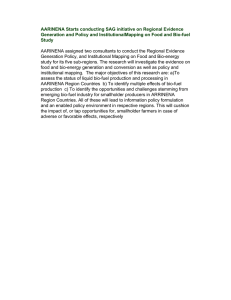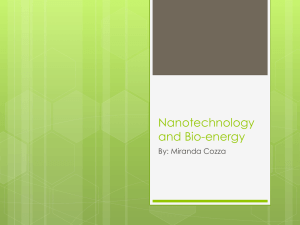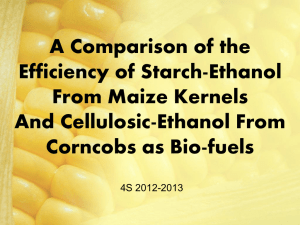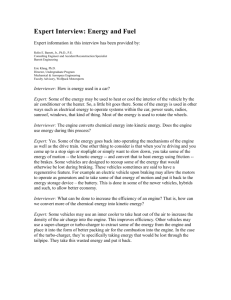Deforestation Diesel
advertisement
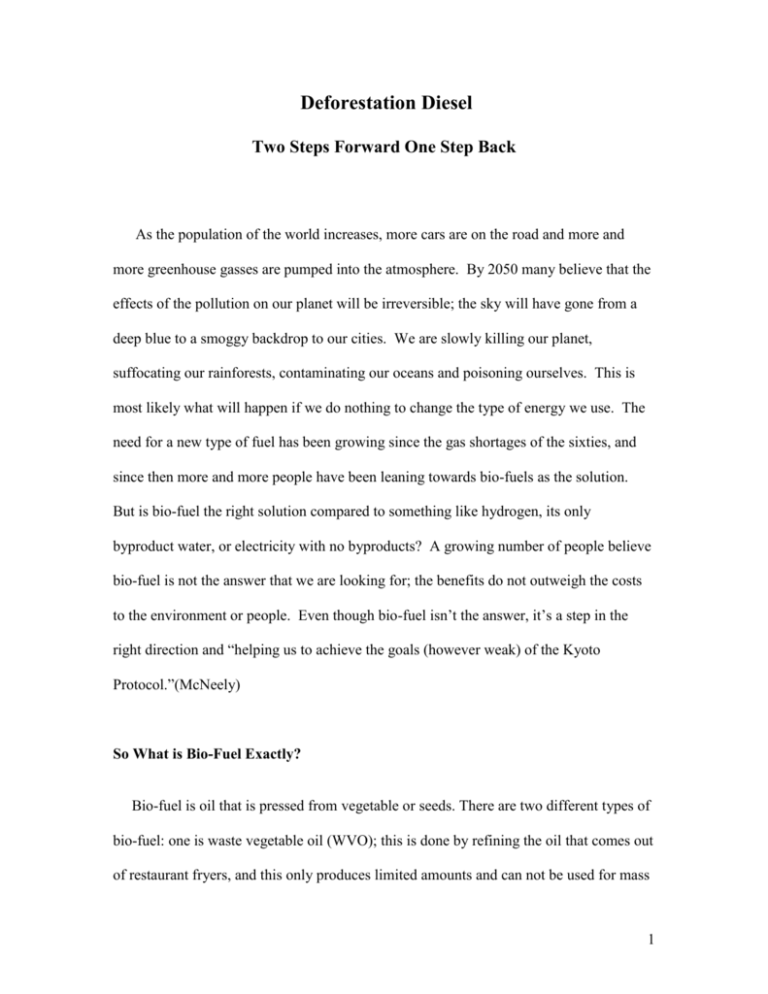
Deforestation Diesel Two Steps Forward One Step Back As the population of the world increases, more cars are on the road and more and more greenhouse gasses are pumped into the atmosphere. By 2050 many believe that the effects of the pollution on our planet will be irreversible; the sky will have gone from a deep blue to a smoggy backdrop to our cities. We are slowly killing our planet, suffocating our rainforests, contaminating our oceans and poisoning ourselves. This is most likely what will happen if we do nothing to change the type of energy we use. The need for a new type of fuel has been growing since the gas shortages of the sixties, and since then more and more people have been leaning towards bio-fuels as the solution. But is bio-fuel the right solution compared to something like hydrogen, its only byproduct water, or electricity with no byproducts? A growing number of people believe bio-fuel is not the answer that we are looking for; the benefits do not outweigh the costs to the environment or people. Even though bio-fuel isn’t the answer, it’s a step in the right direction and “helping us to achieve the goals (however weak) of the Kyoto Protocol.”(McNeely) So What is Bio-Fuel Exactly? Bio-fuel is oil that is pressed from vegetable or seeds. There are two different types of bio-fuel: one is waste vegetable oil (WVO); this is done by refining the oil that comes out of restaurant fryers, and this only produces limited amounts and can not be used for mass 1 production of bio-fuel. The second way is by using SVO or straight vegetable oil which is the oil pressed from certain vegetable and seeds; this is the way that mass amounts of oil are produced. Either way they must both go through a process called transesterification: “Transesterification is the reaction of oil with an alcohol to form esters and glycerol, transesterification is the process of exchanging the alkoxy group of an ester compound by another alcohol. The reactions are often catalyzed by an acid or a base. Transesterification is crucial for producing biodiesel from biolipids” (“Bio-fuels (alcohols and biodiesel) applications as fuels for internal combustion engines,” Avinash Kumar Agarwal). This reaction makes the bio-fuel less viscous and easier to run in a diesel. Before transesterification, the oil is too thick and will not atomize correctly. In an unmodified diesel engine, this can cause a build up of carbon from the fuel which is bad for the engine. This process also helps keep the rest of the engine clean; it keeps the valves from developing a gum and ruining the injection timing which would make the engine misfire, not start well in the cold, cause the engine to knock, and eventually cause engine failure due to lack of lubrication oil. After transesterification it can run in an unmodified diesel engine. All in Favor One of the big drawbacks to petroleum fuels besides the pollution is that they are not renewable. The reserves – known and affordable supplies of a nonrenewable resource such as oil – are considered economically depleted when 80% of the supply has been used; the remaining 20% is considered too expensive to extract. Oil’s fatal flaw is that its reserves may be 80% depleted within 35–84 years, depending on how 2 rapidly it is used. At the current rate of consumption, global oil reserves will last at least 44 years. Undiscovered oil that is thought to exist might last another 20–40 years. Instead of remaining at the current level, however, global oil consumption is projected to increase by about 25% by 2010. This will hasten depletion of global oil reserves. (Puppan) But since bio-fuel is a plant product, it can be renewed just as fast as the crop can grow. Unlike the dwindling supply of petroleum in the world, as many crops could be grown as needed to supply enough oil. Instead of using what has taken millions of years to form, fuel can now be reproduced within a year. The plants that grow the fuels serve a purpose; these plants absorb CO2, and possibly even enough to offset the CO2 produced by burning the bio-fuel. This makes bio-fuel a CO2 neutral source which is a far leap from today’s CO2 emitting fuels. Daniel Puppan talks about how bio-fuel will have a tremendous benefit on the environment within the next 50 years in his essay “Environmental Evaluation of Bio-Fuels.” Although there are a few drawbacks to biofuel which he clearly points out in his essay, in his opinion the benefits of bio-diesel and ethanol seem to make up for their drawbacks. Puppan talks about how carbon can be reabsorbed by the growing crops in his essay “The life-cycle assessment of bio-diesel and ethanol has proved that their impact on the environment during the entire life-cycle is much more favorable than those of the conventional fuels (diesel, gasoline), provided the agricultural, climate conditions are advantageous.” Bio-fuel would also have an economic benefit. An article by The Globalist discusses the possibility of turning usually impoverished countries into tomorrow’s oil brokers: “Of the world's 47 poorest countries — 38 are net oil importers and 25 of these import all of their oil. Yet many of these countries have substantial agricultural bases and 3 are well-positioned to grow highly productive energy crops.” This would create more jobs for the world’s poorest people and create a greater export market for these countries, creating greater revenue. “Between 1975 and 1987, ethanol, a plant fuel product, saved Brazil $10.4 Billion in foreign exchange.”(The Globalist) These economic benefits would also help boost the global economy, making everyone better off. The Hidden Truths As great as all of the above sounds, there are many things that the bio-fuel industries don’t want people knowing, just like the petroleum industries try to keep their blemishes a secret. Let’s start with the obvious: since it is more viscous then traditional diesel it does not atomize (when fuel is injected into the cylinders it spreads out in to a very fine vapor so that it burns more completely) as well in the engine. This makes the engine less efficient “only getting about 70% of the mileage of petrol. And the cut in CO2 is only about 13% due to the pollution created in production” (McNeely). So much more fuel is required to go as far and keep the same amount of horsepower as petroleum engines. SVO is what is used to create mass amounts of bio-fuel, but where do you grow these types of plants? The plants that produce most of the world’s bio-oils are only grown in tropical regions near the equator. The problem is in this region there is not much agricultural land at all, so to make room for the plantations, forests are being slashed and burned: …A miasma of choking haze has sent pollution readings off the chart and health authorities are warning of much worse to come As in years past, the foul air is the direct result of raging forest fires across the waters in Indonesia’s Sumatra region. As villagers and farmers clear land for logging and the export of tropical timber 4 and planting of a variety of agricultural products… Indonesia’s slash and burn wave owes much to the soaring demand for environmentally friendly bio-fuels (Shameen Assif “Southeast Asia’s Clean Air Conundrum”). Even though the plants that grow the bio-crops offset the CO2 produced by the burning of the CO2, the amount that is created from the burning of the forests is rivaling that of petroleum in production of greenhouse gasses. Bio-fuel is not as economically friendly as some make it out to be. “The amount of grains it takes to fill a Range Rover is sufficient to feed one person for a year. Assuming that the tank is refilled every two weeks one car can use enough grain to feed a hungry African village for a year” (McNeely). That doesn’t sound very efficient to me, and with the rising costs of food all around the world that could make bio-fuel very expensive. Even if countries imposed taxes on bio-fuels the cost would end up being so high that no one would ever be able to afford enough to run a vehicle. Not to mention that if one car took this much grain to fuel it, if every car on the planet was eventually switched over then the entire world’s rainforests would be wiped out for the production of a product that is supposed to be environmentally friendly. Alternatives to the Alternative More and more options for fuel are becoming available every day; things like hydrogen and even talk of a pure air fueled vehicles has risen in that past few years. But if not bio-fuel which one of these could be that answer that we are looking for? Each one of these is cleaner to produce than bio-fuel. Hydrogen is just extracted from water; it can be created using electricity not fossil fuels. In cars it is possibly 2 to 3 times more 5 efficient than today’s fuels. So why not? Well as easy as the production of hydrogen sounds, it is extremely expensive and time consuming. At this time producing mass amounts of hydrogen would take too long and we would go through periods of abundance and absolute scarcity. Until technology is able to give us a cheaper and quicker means of production then we probably should keep looking. Air, it is all around us, we need it to survive, to fuel us. It was only a matter of time before someone thought up a way to power a car just using air. Modern cars already use air in their engines; so would bio-fuel cars. In order to combust the fuel you need to combine it with air. The idea behind an air powered car is mostly compression. A manufacturer in France has been developing a car that uses compressed air to turn a piston and drive the wheels. Great steps are being made to try to make a more efficient model. The model in use now only has a top speed of ~95 k.m.h or roughly 60 miles per hour, and can run for around 100 miles with our refueling. Refueling would be a snap, just plug your car into an air pump that you would usually use to pump up your tires and your car would be ready to go. With no burning of anything in this engine it is completely emissions free; after the air turns the piston it is just expelled from the car. As soon as a longer lasting version of this air engine is available we will most likely start to see them on the streets. So what now, do we stick with the petroleum engine till we run out or can’t walk in the streets without a gas mask? It would make more sense for the oil companies to take some of their billions of dollars and invest it in research and development of future fuels. This is obviously where they will make more money in the future when we can no longer burn fossil fuels. 6 Conclusion The benefits of bio-fuel do not seem to me to be enough to make up for its shortcomings. It seems paradoxical to use a cleaner burning fuel that pollutes more petroleum before it is even burned. Not to mention, “it’s technology gone mad,” but at least people are starting to look in the right direction (S.M. Idris qutd. in Shameen). Many companies are realizing that bio-fuel at this time is not feasible; they are trying to alter the plants to make them more efficient to try to make up for the burning of the forests. But until these modifications are made and tested we are not doing the right thing in terms of environmental protection. There are many other options and we need to start exploring them to find the best possible answer. Electricity has been used to power cars for a few decades now and great advancements have made electric cars much more powerful. Along with hydrogen and air we may have found a few different answers, and perhaps someday in the not too distant future we won’t hear the loud rumble of a gasoline powered cars, just the quiet clean hum of electric cars passing silent hydrogen cars under a pristine blue haze-less sky. 7 Works Cited Agarwal, Avinash Kumar. "Bio-fuels (Alcohol and Bio-diesel) Applications as Fuel for Internal Combustion Engine." Science Direct 33. 311 2006 233-271. 3 27 2007 <http://www.sciencedirect.com> The Globalist, "The Global Benefits of Biofuels." The Globalist . 15 06 2006. The Globalist. 09 04 2007<www.theglobalist.com/ storyid.aspx?StoryId=5409 >. McNeely, Jeffery A. "Biofuels: Green Energy or Grim Reaper. " Science/Nature The Green Room. 22 09 2006. BBC News . 09 04 2007 <http://news.bbc.co.uk/2/hi/science/nature/5369284.stm>. Puppan, Daniel. “Environmental Evaluation of Bio-fuel.” Periodica Polytichnica. 9 2002 10. 3 27 2007<http://www.pp.bme.hu/so/2002_1/pdf/so2002_1_08.pdf> Shameen, Assif. “Southeast Asia’s Clean Air Conundrum.” Business Week Online. 10 2006 2. 3 27 2007<http://www.businessweek.com/globalbiz/content/cot20 06/gb20061017_901240.htm?chan=search> 8
